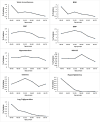Contribution of Conventional Cardiovascular Risk Factors to Brain White Matter Hyperintensities
- PMID: 37421292
- PMCID: PMC10382123
- DOI: 10.1161/JAHA.123.030676
Contribution of Conventional Cardiovascular Risk Factors to Brain White Matter Hyperintensities
Abstract
Background White matter hyperintensities (WMHs) are a major risk factor for stroke and dementia, but their pathogenesis is incompletely understood. It has been debated how much risk is accounted for by conventional cardiovascular risk factors (CVRFs), and this has major implications as to how effective a preventative strategy targeting these risk factors will be. Methods and Results We included 41 626 UK Biobank participants (47.2% men), with a mean age of 55 years (SD, 7.5 years), who underwent brain magnetic resonance imaging at the first imaging assessment beginning in 2014. The relationships among CVRFs, cardiovascular conditions, and WMH volume as a percentage of total brain volume were examined using correlations and structural equation models. Only 32% of the variance in WMH volume was explained by measures of CVRFs, sex, and age, of which age accounted for 16%. CVRFs combined accounted for ≈15% of the variance. However, a large portion of the variance (well over 60%) remains unexplained. Of the individual CVRFs, blood pressure parameters together accounted for ≈10.5% of the total variance (diagnosis of hypertension, 4.4%; systolic blood pressure, 4.4%; and diastolic blood pressure, 1.7%). The variance explained by most individual CVRFs declined with age. Conclusions Our findings suggest the presence of other vascular and nonvascular factors underlying the development of WMHs. Although they emphasize the importance of modification of conventional CVRFs, particularly hypertension, they highlight the need to better understand risk factors underlying the considerable unexplained variance in WMHs if we are to develop better preventative approaches.
Keywords: cardiovascular risk factors; magnetic resonance imaging; structural equation modeling; white matter hyperintensities.
Figures



References
-
- Lam BYK, Cai Y, Akinyemi R, Biessels GJ, van den Brink H, Chen C, Cheung CW, Chow KN, Chung HKH, Marco Duering M, et al. The global burden of cerebral small vessel disease in low‐and middle‐income countries: a systematic review and meta‐analysis. Int J Stroke. 2023;18:15–27. doi: 10.1177/17474930221137019 - DOI - PubMed
-
- Williamson JD, Pajewski NM, Auchus AP, Bryan RN, Chelune G, Cheung AK, Cleveland ML, Coker LH, Crowe MG, Cushman WC, et al. SPRINT MIND investigators for the SPRINT research group: effect of intensive vs standard blood pressure control on probable dementia: a randomized clinical trial. JAMA. 2019;321:553–561. doi: 10.1001/jama.2018.21442 - DOI - PMC - PubMed
Publication types
MeSH terms
Grants and funding
LinkOut - more resources
Full Text Sources
Medical

